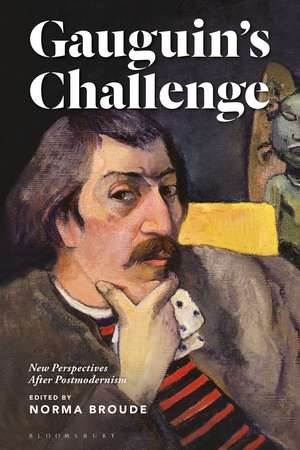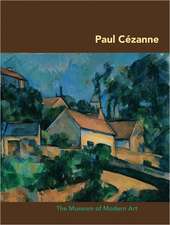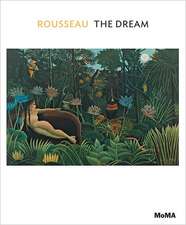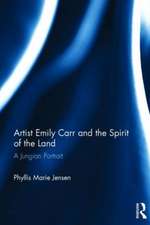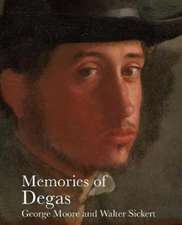Gauguin’s Challenge: New Perspectives After Postmodernism
Editat de Dr. Norma Broudeen Limba Engleză Paperback – 7 mar 2018
Preț: 203.10 lei
Nou
Puncte Express: 305
Preț estimativ în valută:
38.87€ • 40.53$ • 32.30£
38.87€ • 40.53$ • 32.30£
Carte disponibilă
Livrare economică 28 februarie-14 martie
Preluare comenzi: 021 569.72.76
Specificații
ISBN-13: 9781501342509
ISBN-10: 1501342509
Pagini: 328
Ilustrații: 8 color and 65 bw illus
Dimensiuni: 152 x 229 mm
Greutate: 0.61 kg
Editura: Bloomsbury Publishing
Colecția Bloomsbury Visual Arts
Locul publicării:New York, United States
ISBN-10: 1501342509
Pagini: 328
Ilustrații: 8 color and 65 bw illus
Dimensiuni: 152 x 229 mm
Greutate: 0.61 kg
Editura: Bloomsbury Publishing
Colecția Bloomsbury Visual Arts
Locul publicării:New York, United States
Notă biografică
Norma Broude is Professor Emerita of Art History at American University, USA. A pioneering feminist scholar and specialist in 19th-century French and Italian painting, Broude is known for critical reassessments of Impressionism and the work of Gauguin, Degas, Caillebotte, Cassatt, Seurat, and the Italian Macchiaioli. She is also co-editor of four influential texts on feminist art history.
Cuprins
List of PlatesList of FiguresList of AbbreviationsPreface and AcknowledgmentsIntroduction: Gauguin After PostmodernismNorma Broude (American University, USA)Part I: Constructing Multiple Identities1. Gauguin's Alter Egos: Writing the Other and the SelfLinda Goddard (University of St Andrews, UK)2. Paul Gauguin's Self-Portraits in Polynesia: Androgyny and AmbivalenceIrina Stotland (Montgomery College, USA)3. Flora Tristan's Grandson: Reconsidering the Feminist Critique of Paul GauguinNorma Broude (American University, USA)Part II: Symbolism, Science, and Spirituality4. Gauguin and the Challenge of AmbiguityDario Gamboni (Université de Genève, Switzerland)5. On Not Seeing Tahiti: Gauguin's Noa Noa and the Rhetoric of BlindnessAlastair Wright (University of Oxford, UK)6. Evolution and Desire in Gauguin's Tahitian EveMartha Lucy (The Barnes Foundation)7. Gauguin: Vitalist, HypnotistBarbara Larson (University of West Florida, USA)8. "All Men Could Be Buddhas": Paul Gauguin's Marquesan DiptychJune E. Hargrove (University of Maryland, College Park, USA)Part III: Reception: Resistance and Empowerment9. Taking Back Teha'amana: Feminist Interventions in Gauguin's LegacyElizabeth C. Childs (Washington University in St. Louis, USA)10. Re-Possessing Gauguin: Material Histories and the Contemporary PacificHeather Waldroup (Appalachian State University, USA)Notes on ContributorsBibliographyIndex
Recenzii
Gauguin's Challenge is a rich survey of recent scholarship that admirably shows this artist's relevance for our politically fraught present.
[Provides] fresh perspectives in Gauguin studies.
I didn't think it could be done: A new collection of essays about Gauguin that contains original research and new conclusions. And important ones too, about gender, sex, vision, religion, power, identity and colonialism. This is a Gauguin for the 21st century!
Because he lived his own romantic myth, we inherit a Gauguin as notorious as he is renowned. Our current histories of modernism slight him in favor of Cézanne, Monet, and Van Gogh, whose positions are easier to define. But no one grasped the stakes of modernist practice better than Gauguin did-even as its attitudes and forms were only just emerging. This collection of new analyses and assessments by noted scholars acknowledges the full complexity of Gauguin and his world, spurred by issues that concern our society now, which we discern in him as well. The topics addressed range from otherness, to androgyny, to feminism, to pictorial ambiguity, to vitalism, to sexuality, to religiosity. Because the central figure in each study is Gauguin-the same artist, yet not the 'same' object-the various interpretations intersect from chapter to chapter, making this book fascinating as a historical document in itself.
The diversity of scholarly voices assembled by Norma Broude in Gauguin's Challenge provides a rich variety of perspectives on the artist's disputed colonialist imagery of the exotic French Polynesia of the 1890s. Just as Gauguin's postimpressionist art challenged the aesthetic, political, racial, and sexual standards of his day, so does his beautiful and disturbing art remain a challenge for us to face up to its complexities and contradictions. This passionate volume shows how productive the unfinished conversation on Gauguin can still be for artists, professors, students, and the general public.
Gauguin's Challenge is a must-read for anyone interested in delving more deeply into the question asked by Norma Broude in her introduction to the book: "How do we or should we now understand Gauguin?" As the title cleverly underscores, the challenge is twofold: both ours and the artist's. From the viewpoint of recent generations, Gauguin was an exploitative colonizer and victimizer, but the essays in this volume complicate that picture. Contributions by internationally recognized Gauguin experts including Norma Broude, Elizabeth Childs, Dario Gamboni, Linda Goddard, June Hargrove and Alastair Wright, as well as scholars in the richly interdisciplinary field of Pacific Studies, provide fresh and important perspectives from which to reconsider his life and art. An ambivalent participant in France's Catholic traditions and categories, Gauguin here comes across as an even more complex personality, as much victim as victimizer, whose production as artist, craftsman, printmaker, feminist (yes, feminist!), and writer is decidedly worthy of the balanced insights and deep analysis these essays offer.
With Gauguin's Challenge Norma Broude succeeds in presenting a collection of insightful articles by diverse authors who analyze Gauguin's art and writing. Reassessing both the artist's work and historic persona beyond pioneering postcolonial and feminist critiques, this book contributes masterfully to advancing Gauguin studies.
[Norma] Broude's book is an important bookend to an era of art history. It leads us to a new approach that will encourage us to listen to the voices of indigenous peoples as they share with us their history, beliefs, and observations about Paul Gauguin's work.
[Provides] fresh perspectives in Gauguin studies.
I didn't think it could be done: A new collection of essays about Gauguin that contains original research and new conclusions. And important ones too, about gender, sex, vision, religion, power, identity and colonialism. This is a Gauguin for the 21st century!
Because he lived his own romantic myth, we inherit a Gauguin as notorious as he is renowned. Our current histories of modernism slight him in favor of Cézanne, Monet, and Van Gogh, whose positions are easier to define. But no one grasped the stakes of modernist practice better than Gauguin did-even as its attitudes and forms were only just emerging. This collection of new analyses and assessments by noted scholars acknowledges the full complexity of Gauguin and his world, spurred by issues that concern our society now, which we discern in him as well. The topics addressed range from otherness, to androgyny, to feminism, to pictorial ambiguity, to vitalism, to sexuality, to religiosity. Because the central figure in each study is Gauguin-the same artist, yet not the 'same' object-the various interpretations intersect from chapter to chapter, making this book fascinating as a historical document in itself.
The diversity of scholarly voices assembled by Norma Broude in Gauguin's Challenge provides a rich variety of perspectives on the artist's disputed colonialist imagery of the exotic French Polynesia of the 1890s. Just as Gauguin's postimpressionist art challenged the aesthetic, political, racial, and sexual standards of his day, so does his beautiful and disturbing art remain a challenge for us to face up to its complexities and contradictions. This passionate volume shows how productive the unfinished conversation on Gauguin can still be for artists, professors, students, and the general public.
Gauguin's Challenge is a must-read for anyone interested in delving more deeply into the question asked by Norma Broude in her introduction to the book: "How do we or should we now understand Gauguin?" As the title cleverly underscores, the challenge is twofold: both ours and the artist's. From the viewpoint of recent generations, Gauguin was an exploitative colonizer and victimizer, but the essays in this volume complicate that picture. Contributions by internationally recognized Gauguin experts including Norma Broude, Elizabeth Childs, Dario Gamboni, Linda Goddard, June Hargrove and Alastair Wright, as well as scholars in the richly interdisciplinary field of Pacific Studies, provide fresh and important perspectives from which to reconsider his life and art. An ambivalent participant in France's Catholic traditions and categories, Gauguin here comes across as an even more complex personality, as much victim as victimizer, whose production as artist, craftsman, printmaker, feminist (yes, feminist!), and writer is decidedly worthy of the balanced insights and deep analysis these essays offer.
With Gauguin's Challenge Norma Broude succeeds in presenting a collection of insightful articles by diverse authors who analyze Gauguin's art and writing. Reassessing both the artist's work and historic persona beyond pioneering postcolonial and feminist critiques, this book contributes masterfully to advancing Gauguin studies.
[Norma] Broude's book is an important bookend to an era of art history. It leads us to a new approach that will encourage us to listen to the voices of indigenous peoples as they share with us their history, beliefs, and observations about Paul Gauguin's work.
